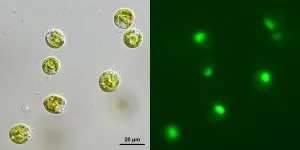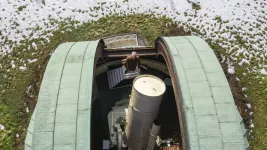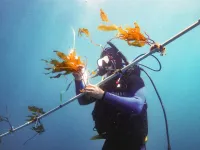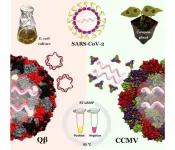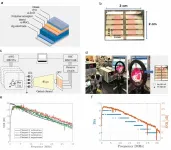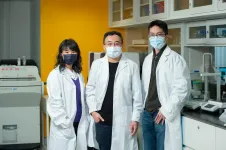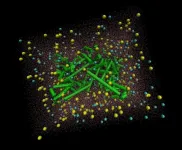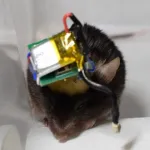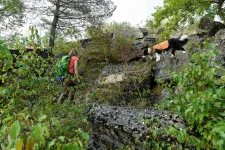(Press-News.org) New research suggests that the ability of green algae to eat bacteria is likely much more widespread than previously thought, a finding that could be crucial to environmental and climate science. The work, led by scientists at the American Museum of Natural History, Columbia University, and the University of Arizona, found that five strains of single-celled green algae consume bacteria when they are "hungry," and only when those bacteria are alive. The study is published today in The ISME Journal.
"Traditionally, we think of green algae as being purely photosynthetic organisms, producing their food by soaking in sunlight," said Eunsoo Kim, an associate curator at the American Museum of Natural History and one of the study's corresponding authors. "But we've come to understand that there are potentially a number of species of green algae that also can eat bacteria when the conditions are right. And we've also found out just how finicky they are as eaters."
In 2013, Kim and her colleagues were the first to provide definitive proof that green algae eat bacteria, which they showed in an alga from the genus Cymbomonas. While some in the field viewed this behavior as a rare exception, Kim's lab continued to explore whether mixotrophy--the term that describes the mode by which organisms use both photosynthesis and phagocytosis (cell-eating) to power themselves--existed in other types of green algae. It was a difficult behavior to confirm until the research team came up with a new experimental approach led by Nicholas Bock, a graduate student at Columbia University's Lamont-Doherty Earth Observatory, and Museum postdoctoral researcher Sophie Charvet.
The researchers conducted feeding experiments with live bacteria that were labeled with a non-toxic fluorescent dye and combined the bacteria with five different strains of unicellular green algae called prasinophytes for analyses through a flow cytometer, which helps scientists analyze cell properties in solution. The flow cytometer measured increasing levels of green fluorescence in the algal cells over time, suggesting that the algae were consuming the glowing bacteria. To confirm that ingestion was actually occurring, the researchers used high-precision microscopy to pinpoint the origin of the green fluorescence to the interior of the algal cells. In the process, the team discovered two particular quirks about the finicky eaters: the algal strains they tested only ate live bacteria (dead bacteria in the experiments were left untouched), and they ate more when the levels of other nutrients were low. These findings have large implications for the environmental study of green algae.
"Traditionally when people study bacterial ingestion by algae in the oceans for environmental samples, they use fluorescently labeled bacteria that have been killed in the labeling process," Charvet said. "At least for the five algal strains we had in culture, they preferentially feed on the live bacteria and seem to be snubbing the killed bacteria. This means that the impact of algae on bacterial communities in their natural environment has possibly been underestimated drastically because of the methods used."
Green algae are found around the world and help form the foundation of the aquatic food web. Along with other photosynthetic organisms like cyanobacteria, diatoms, and dinoflagellates--which are given the umbrella term phytoplankton--green algae function as a sort of biological carbon pump, consuming carbon dioxide on a scale equivalent to trees and other land plants in terrestrial ecosystems.
"For decades, scientists have been able to send satellites up and get optical data to infer global distributions of phytoplankton via chlorophyll measurement," said Bock, who conducted the work at Columbia under Solange Duhamel, now at the University of Arizona, Tucson. "Through that, we've come to understand that phytoplankton are vitally important for carbon cycling. The assumption in all of this is that all that chlorophyll just represents photosynthesis. It doesn't account for the mixotrophy piece because there's no easy way to detect [via satellite] if they're eating other cells. Our findings highlight that the story is actually more complex."
In parallel to the experiments led by Bock and Charvet, green algal bacteria-eating was investigated using a gene-based prediction model formulated by John Burns from the American Museum of Natural History and the Bigelow Laboratory for Ocean Sciences. The predictions agreed with the experimental results and suggested that the behavior is even more widespread among the green algal tree of life.
INFORMATION:
Other authors of this work include Yangtsho Gyaltshen from the American Museum of Natural History and Andrey Rozenberg from the Israel Institute of Technology.
This work was supported in part by the U.S. National Science Foundation no.s CAREER-1453639, OCE-14580950, and OCE-1458070, and the Simons Foundation grant no. 382790.
Study DOI: 10.1038/s41396-021-00899-w
ABOUT THE AMERICAN MUSEUM OF NATURAL HISTORY (AMNH)
The American Museum of Natural History, founded in 1869 and currently celebrating its 150th anniversary, is one of the world's preeminent scientific, educational, and cultural institutions. The Museum encompasses more than 40 permanent exhibition halls, including those in the Rose Center for Earth and Space, as well as galleries for temporary exhibitions. The Museum's approximately 200 scientists draw on a world-class research collection of more than 34 million artifacts and specimens, some of which are billions of years old, and on one of the largest natural history libraries in the world. Through its Richard Gilder Graduate School, the Museum grants the Ph.D. degree in Comparative Biology and the Master of Arts in Teaching (MAT) degree, the only such free-standing, degree-granting programs at any museum in the United States. The Museum's website, digital videos, and apps for mobile devices bring its collections, exhibitions, and educational programs to millions around the world. Visit amnh.org for more information.
An international team led by Prof. dr habil. Andrzej Niedzielski, an astronomer from the Nicolaus Copernicus University in Torun (Poland), has discovered yet another three extrasolar planets. These planets revolve around the stars that can be called elder sisters of our Sun.
You can read about the astronomers' success in Astronomy and Astrophysics. The prestigious European journal will publish the paper: Tracking Advanced Planetary Systems (TAPAS) with HARPS-N. VII. Elder suns with low-mass companions. Apart from Prof. Andrzej Niedzielski from the NCU Institute of Astronomy, the team which worked on the discovery includes Prof. dr habil. Gracjan Maciejewski, also from the NCU Faculty of Physics, Astronomy and Informatics, Prof. Aleksander Wolszczan (Pennsylvania State ...
For several years now, the biofuels that power cars, jet airplanes, ships and big trucks have come primarily from corn and other mass-produced farm crops. Researchers at USC, though, have looked to the ocean for what could be an even better biofuel crop: seaweed.
Scientists at the USC Wrigley Institute for Environmental Studies on Santa Catalina Island, working with private industry, report that a new aquaculture technique on the California coast dramatically increases kelp growth, yielding four times more biomass than natural processes. The technique employs a contraption called the "kelp elevator" ...
Australia's marine World Heritage Sites are among the world's largest stores of carbon dioxide according to a new report from the United Nations, co-authored by an ECU marine science expert.
The UNESCO report found Australia's six marine World Heritage Sites hold 40 per cent of the estimated 5 billion tons of carbon dioxide stored in mangrove, seagrass and tidal marsh ecosystems within UNESCO sites.
The report quantifies the enormous amounts of so-called blue carbon absorbed and stored by those ecosystems across the world's 50 UNESCO marine World Heritage Sites.
Despite covering less ...
Rapid COVID-19 tests are on the rise to deliver results faster to more people, and scientists need an easy, foolproof way to know that these tests work correctly and the results can be trusted. Nanoparticles that pass detection as the novel coronavirus could be just the ticket.
Such coronavirus-like nanoparticles, developed by nanoengineers at the University of California San Diego, would serve as something called a positive control for COVID-19 tests. Positive controls are samples that always test positive. They are run and analyzed right alongside patient samples to verify that COVID-19 tests are working consistently and as intended.
The positive controls developed at UC San Diego offer several advantages over the ones currently used in COVID-19 testing: ...
Around the world there are currently more than 18 billion internet-connected mobile devices. In the next 10 years, anticipated growth in the Internet of Things (IoT) and in machine-type communication in general, will lead to a world of hundreds of billions of data-connected objects. Such growth poses two very challenging problems:
How can we securely connect so many wireless devices to the Internet when the radio-frequency bandwidth has already become very scarce?
How can all these devices be powered?
Regular, manual charging of all mobile Internet-connected devices will not be feasible, and connection to ...
A Hong Kong Baptist University-led (HKBU) research team has developed a novel drug which has the potential to become a next-generation treatment for cancers associated with Epstein-Barr virus (EBV).
The peptide-linked drug, which is responsive to the acidic environment found in tumours, is the first known agent to have successfully targeted two viral proteins that are simultaneously produced by EBV. It also offers a new strategy by increasing the uptake of anti-cancer drugs in tumour cells, thus allowing the application of lower drug dosages which helps reduce treatment side effects and health risks.
The research results were published in the international academic journal Advanced Science.
New drug targets ...
Modern electronics is approaching the limit of its capabilities, which are determined by the fundamental laws of physics. Therefore, the use of classical materials, for example, silicon, is no longer able to meet the requirements for energy efficiency of the devices. Currently, it is necessary to start searching for new materials, new principles of electronic devices' functioning. To solve this problem, researchers of Peter the Great St.Petersburg Polytechnic University (SPbPU) are developing thin films, the elements for biomolecular electronics. Scientists believe that biological macromolecules such as nucleic acids, proteins, amino acids can become a promising material for modern ...
Overview:
A research team at the Department of Electrical and Electronic Information Engineering, Department of Computer Science and Engineering, Department of Applied Chemistry and Life Science, and the Electronics-Inspired Interdisciplinary Research Institute (EIIRIS) at Toyohashi University of Technology has developed a lightweight, compact, Bluetooth-low-energy-based wireless neuronal recording system for use in mice. The wireless system weighs END ...
A number of scientists whose work is inspired by natural behavior is constantly growing. The lotus flower, with its ability to self- clean, is commonly described in literature and can be best examples the trend. Researchers started to wonder why the flower behaves in this manner and they decided to study its structure with the use of microscopes. Hence, they could draw the conclusion that the structure is highly hydrophobic, i.e. it maintains water drops on the surface. Water then collects particles of dust and by flowing down, removes them by flowing down. It means the adhesion forces, those responsible ...
The lists of Earth's endangered animals and plants are getting increasingly longer. But in order to stop this trend, we require more information. It is often difficult to find out exactly where the individual species can be found and how their populations are developing. According to a new overview study published in Methods in Ecology and Evolution by Dr Annegret Grimm-Seyfarth from the Helmholtz Centre for Environmental Research (UFZ) and her colleagues, specially trained detection dogs can be indispensable in such cases. With the help of these dogs, the species sought can usually be found faster and more effectively than with other methods.
How many otters are there ...
